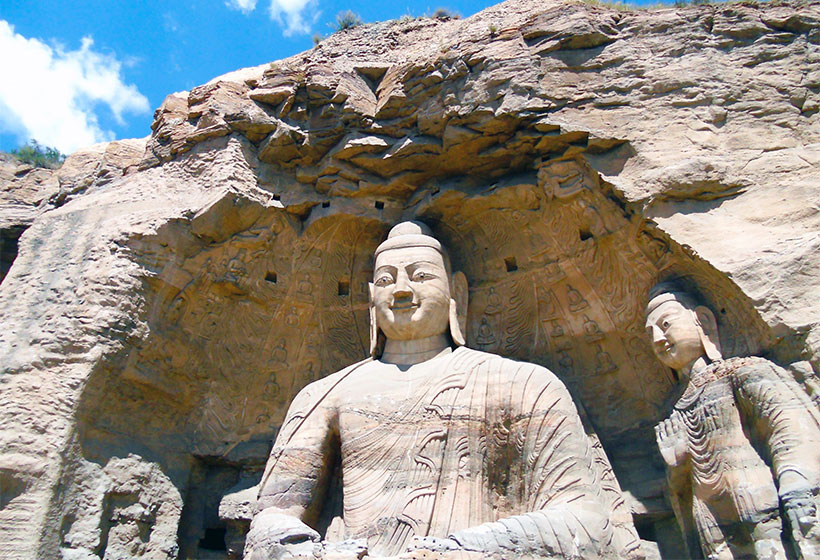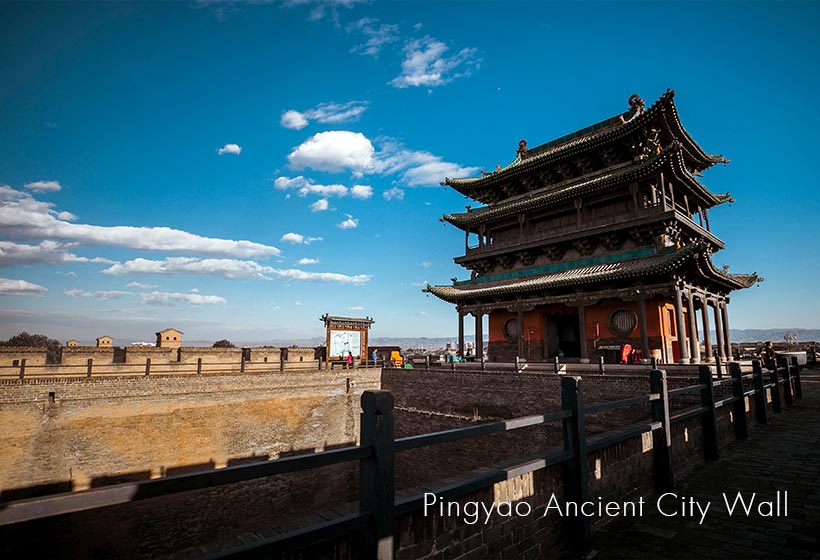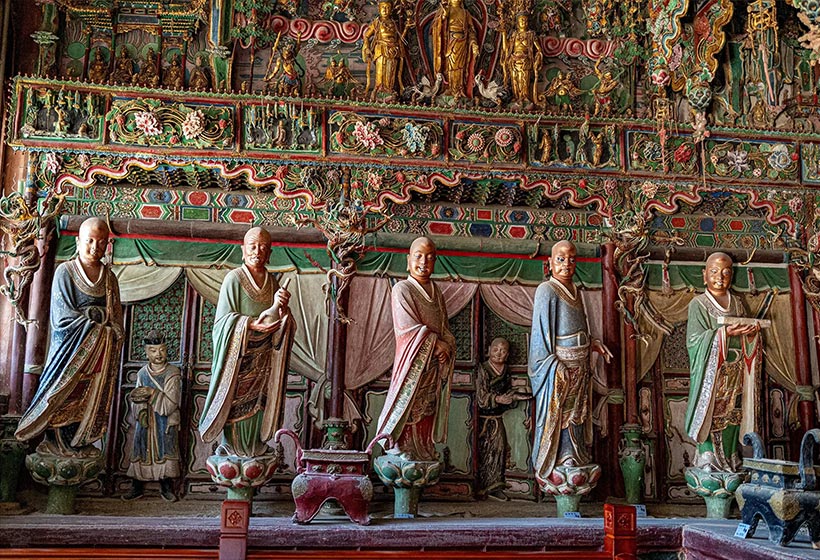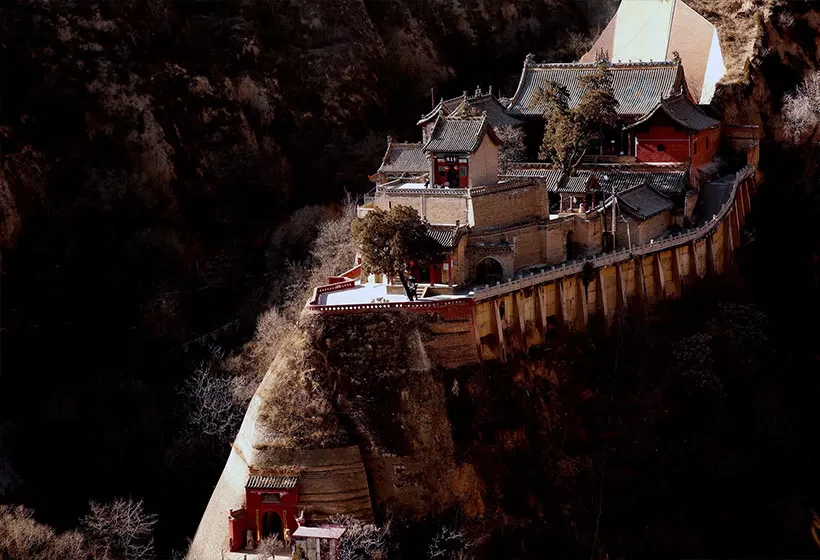Top 10 Famous Tourist Attractions and Sightseeing in Shanxi
Shanxi Province, with its rich history and deep cultural roots, is a captivating destination that beautifully blends nature and human heritage. The province is home to breathtaking scenic spots, each combining stunning natural landscapes with profound historical significance.
Recently, Shanxi has gained further popularity as a photographing location for the highly anticipated game Black Myth: Wukong. Iconic sites such as Mount Wutai and the Yungang Grottoes feature prominently in the game, making it an exciting opportunity for fans to visit these real-life locations in person. Following are the Shanxi top 10 attractions.
Top 1: Yungang Grottoes
 Yungang Grottoes
Yungang GrottoesYungang Grottoes, originally known as Stone Buddha Temple, is one of China's most famous grotto complexes. Carved into the mountainside, the grottoes stretch approximately one kilometer from east to west, with the site naturally divided into three areas: east, middle, and west. The construction of Yungang Grottoes spanned around 150 years, across multiple dynasties. Today, there are 45 major caves, 252 minor niches, and over 59,000 stone statues, making it a treasure trove of Chinese grotto art./
As the first royal-sanctioned grotto complex in China, Yungang Grottoes embodies the political ambitions of the Northern Wei Dynasty. The site reflects a rich blend of influences, incorporating artistic elements from India, Central Asia, and even Greco-Roman architecture and motifs, which makes it a unique masterpiece in the Chinese art canon, holding significant influence on the development of Chinese culture and art.
- Address: the southern foot of Wuzhou Mountain, 17 km west of Datong City, Shanxi Province
- Open Hours: 09:00 AM – 05:00 PM
- Tour Length: 2-12 hours
Top 2: Mount Wutai
Mount Wutai, located in Wutai County in northeastern Xinzhou, is one of China's Four Sacred Buddhist Mountains. As a nationally recognized 5A tourist attraction, Mount Wutai boasts both natural and cultural heritage and is one of the five major Buddhist sanctuaries globally.
Covering an expansive area of 2,837 square kilometers, Mount Wutai is characterized by its five towering peaks, known as the East, West, South, North, and Central Peaks, with Taihuai Town at its heart. The highest peak, Yedou Peak of the North Terrace, stands at an elevation of 3,061 meters and is known as the "Roof of Northern China".
Famed as the sacred site of Manjushri Bodhisattva, Mount Wutai is the only place in China where both Tibetan Buddhism and Han Buddhism coexist harmoniously. This spiritual and scenic destination combines natural beauty, historical relics, architectural art, and Buddhist culture. The area features 47 temples, with 39 within the central area and 8 outside, frequently visited by emperors over the centuries.
- Address: Taihuai Town, Wutai County, Xinzhou City, Shanxi Province
- Open Hours: 00:00 AM – 12:00 PM
- Tour Length: 1-3 days
Top 3: Hukou Waterfalls
Hukou Waterfall is a national-level scenic area and a 5A-rated tourist attraction shared by Shanxi and Shaanxi provinces. It is China's second-largest waterfall and the largest yellow waterfall in the world. The Yellow River flows mightily to this point, where steep stone cliffs stand on both sides, narrowing the river's mouth to resemble the spout of a kettle, thus earning it the name "Hukou" (Kettle Mouth) Waterfall.
Upstream of the waterfall, the Yellow River spans a width of 300 meters, but within a short distance of less than 500 meters, it is compressed to a narrow width of only 20-30 meters. The powerful torrent of water, at a flow rate of 1,000 cubic meters per second, plunges from a height of over 20 meters, creating the awe-inspiring spectacle known as "thousand miles of Yellow River captured in one kettle".
- Address: Hukou Town, Jixian County, Linfen City, Shanxi Province
- Open Hours: 08:00 AM – 06:00 PM
- Tour Length: 2-3 hours
Top 4: Mount Heng
Mount Heng, also known as "Taiheng Mountain", was recognized as the Northern Mountain among the Five Great Mountains of China during the late Ming and early Qing dynasties. Located about 10 kilometers south of Hunyuan County in Shanxi, its main peak, Tianfeng Ridge, reaches an elevation of 2,017 meters, hailed as the "Northern Pillar of Heaven" and a "Famous Mountain of the Northern Frontier".
Stretching from northeast to southwest over hundreds of miles, Mount Heng is split by a large fracture zone through which the Hun River carves its way through steep canyon walls. The gorge between the Tianfeng Ridge and the facing Cuiping Peak is particularly narrow, only 10 meters wide at its thinnest point. Due to its dangerous terrain, this area has historically been a critical strategic point for military forces.
Mount Heng is also an important center for Taoism, specifically the Quanzhen School, with many Taoist structures, and the most famous of which is the Xuankong Temple perched precariously on sheer cliffs.
- Address: No. 203 Provincial Highway, Hunyuan County, Datong City, Shanxi Province
- Open Hours: 08:00 AM – 06:00 PM
- Tour Length: 2-12 hours
Top 5: Yanmen Pass
Yanmen Pass, located in Yanmen Mountain about 20 kilometers north of Daixian County in Xinzhou Shanxi, is a significant pass along the Great Wall, famed for its strategic steepness. Known as "China's First Pass", it holds the reputation of being the foremost among "The Nine Passes Under Heaven." Along with Ningwu Pass and Pian Pass, it forms the trio known as the "Outer Three Passes".
The defensive city walls of Yanmen Pass were constructed to follow the contours of the mountains, spanning more than 5 kilometers in length. The southern ends of the walls connect to the eastern and western wings of the fortress, while the northern walls stretch along the mountain ridges down to the valley, where a city gate is located. Outside the fortress, three large stone walls and 25 smaller walls were built as additional defenses, forming a solid barrier for the pass.
- Address: No. 208 National Highway Yanmenguan Town, Dai County, Xinzhou City, Shanxi Province
- Open Hours: 08:00 AM – 06:00 PM
- Tour Length: 2-4 hours
Top 6: Ancient City of Pingyao
 Ancient City of Pingyao
Ancient City of PingyaoAncient City of Pingyao, located in the central part of Shanxi Province, was founded between 827 and 782 BCE and is the most well-preserved ancient county town in China today. The entire city resembles a turtle crawling southward, earning it the nickname "Turtle City".
Ancient City of Pingyao is a massive architectural complex composed of city walls, shops, streets, temples, and residences. The city's layout is symmetrical, with the Market Tower as its center and South Street as its main axis, forming a traditional feudal configuration. Covering a total area of 2.25 square kilometers, this ancient city comprises four main streets, eight smaller lanes, and 72 winding alleyways, creating the image of a Bagua diagram.
The ancient city showcases over five centuries of China's architectural styles and urban planning evolution, often referred to as a living example for studying ancient Chinese cities. It holds rich and unique value in terms of architecture, religion, commerce, folk customs, and traditional arts.
More about the Ancient City of Pingyao »
- Address: Kangning Road, Pingyao County, Jinzhong City, Shanxi Province
- Open Hours: 08:00 AM – 06:00 PM
- Tour Length: 1-3 days
Top 7: Baquan Gorge
Baquan Gorge, located in Daxiagu Town, Huguan County, Changzhi City, was named for the eight streams that flow from the same source within the gorge. The scenic area is divided into four main sections: the Gate Tower, Canyon, Cable Car, and Walkway landscapes, featuring 36 key attractions.
Baquan Gorge is hailed as the "Most Majestic Gorge of Taihang", occupying a central position in the Taihang Mountain Grand Canyon. Covering an area of 24.11 square kilometers, the gorge ranges in elevation from over 600 meters to over 1,400 meters, with a vertical drop of approximately 1,100 meters. The area has been designated a National Forest Park, National Geological Park, and a national rock climbing base, earning the reputation of being a "world-class tourism treasure".
- Address: Grand Canyon Town, Huguan County, Changzhi City, Shanxi Province
- Open Hours: 07:00 AM – 04:00 PM
- Tour Length: 4-6 hours
Top 8: Qiao Family Courtyard
Qiao Family Courtyard, located in Qiaojiabao Village, Qi County, is a national key cultural relic protection unit, originally built in 1756. The entire complex consists of 6 large courtyards, 20 smaller courtyards, and 313 rooms, covering an area of 4,175 square meters, surrounded by a fully enclosed high blue brick wall over 10 meters tall. Its main entrance resembles a city gate, which is a traditional northern Chinese residential architecture.
The Qiao Family Courtyard exhibits over 5,000 precious cultural relics that reflect the customs and traditions of the Shanxi Jinzhong region. These exhibits include life ceremonies, clothing, commercial customs, and folk crafts. It also features displays about the history of the Qiao family, their treasures, and various film and TV exhibits, holding significant aesthetic, research, and historical value.
More about Qiao Family Compound »
- Address: Qiaojiabao Village, Dongguan Town, Qixian County, Jinzhong City, Shanxi Province
- Open Hours: 08:00 AM – 06:00 PM
- Tour Length: 2-4 hours
Top 9: Jinci Temple
Jinci Temple, located in Jinci Town, Jinyuan District, Taiyuan City, was originally named Jin Wang Shrine. It was built to commemorate Tang Shuyu, the founding prince of the Jin State, and his mother Yi Jiang.
Jinci is the oldest extant royal ancestral garden in China, serving as the ancestral temple of the Jin State. It is an extraordinary representation of ancient Chinese architectural art and an isolated example of the complete architectural type and era sequence from Song dynasties to the Republic of China, with their accompanying sculptures, murals, and stele inscriptions considered as national treasures.
Jinci is also a vital link in the historical and cultural heritage of Shanxi, providing concrete evidence of the transmission of Jin culture from the Western Zhou Dynasty through the Tang Dynasty. Additionally, it is recognized as the ancestral home of the Wang and Zhang families worldwide.
- Address: Jinci Town, Jinyuan District, Taiyuan City, Shanxi Province
- Open Hours: 08:00 AM – 06:00 PM
- Tour Length: 3-4 hours
Top 10: Pagoda of Fogong Temple
The Pagoda of Fogong Temple, also known as the Yingxian Wooden Pagoda, was built in 1056 and is recognized as the tallest and oldest wooden pagoda in the world. Along with the Leaning Tower of Pisa in Italy and the Eiffel Tower in Paris, it is regarded as one of the "Three Great Wonders of the World".
Standing at 67.31 meters tall with a base diameter of 30.27 meters, the pagoda weighs over 7,400 tons. Its primary construction material is northern China larch, with elm wood used for dougong, comprising over 10,000 cubic meters of wood. The base is two-tiered, with a square lower tier and an octagonal upper tier. The body of the pagoda is octagonal, with five visible tiers and six eaves, though the actual structure consists of nine internal floors.
The Pagoda of Fogong Temple is a key example of wooden architecture and holds significant value in the study of ancient Chinese architecture.
- Address: Buddha Palace Temple, Yingxian County, Shuozhou City, Shanxi Province
- Open Hours: 08:00 AM – 06:00 PM
- Tour Length: 1-2 hours
Customize Your Unique Shanxi Tour

If you are interested in one of the Shanxi itineraries mentioned above, please contact us, and we will be happy to customize it and provide a quote tailored to your preferences.
Alternatively, if you would like to customize your Shanxi Tour, please visit our Shanxi Tour Customized Center. We assure you that you will receive a reply within 24 working hours.
Informative Articles for Your Shanxi Trip
 The New West, Xi County
The New West, Xi County- Travel Guide: attractions, weather, hotels, food, etc.
- Top destinations: recommanded places to visit in Shanxi
- Travel itineraries: itineraries for your reference
- Local culture: brief history, folk culture, religion, etc.
- Weather: the best time and seasons to visit Shanxi
- Top attractions: sightseeing to watch in Shanxi
- Cultural immersions: activities to spotlight your trip
- Unique perspective: top different things to do
- Local food: what to eat while traveling in Shanxi
- Luxury hotels: best accommodation to stay in Shanxi
- Shanxi Tours: customized Shanxi tours for your reference
GREAT FAMILY CHINA TOUR
JULY 2024 We wanted to thank Grace at China Culture tour for organizing a great tour of China. We enjoyed our Beijing - Xian-Chengdu -Guilin -Yangshuo - Shanghai trip. Our local guides Bruce in Beijing, Susan in Xian, Jane in Chengdu, Mike in Guilin and Mary in Shanghai took care of us…read more details »
Teng Han L from SINGAPORE
Ready to Create a Unique Dream Travel?


